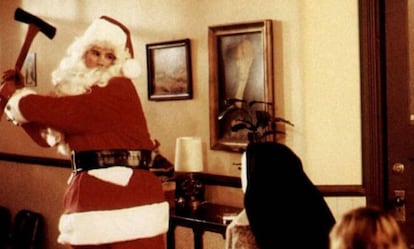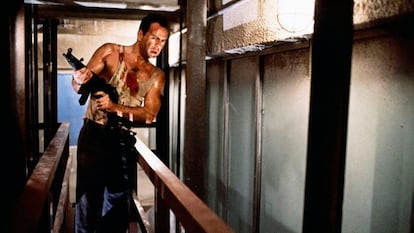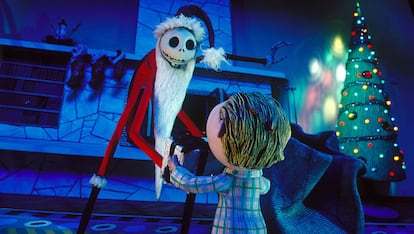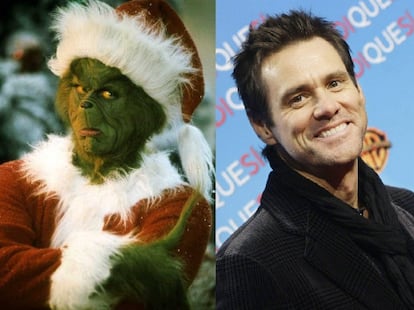A bloody Santa Claus with an ax: These are the films that slash Christmas clichés
A new book analyzes how horror, fantasy, action and comedy have often channeled the opposition to the stereotypical joy of the holidays

In November 1984, various groups of protesters gathered at the doors of the theaters where the horror film Silent Night, Deadly Night was being shown, armed with Christmas carols and banners reading “Save Santa Claus” and “We Love Santa Claus.” The movie in question revolved around a five-year-old boy who witnesses a thief dressed as Santa Claus raping his mother and killing both his parents, a trauma that turns him into a homicidal, psychopathic adult that characterizes himself as a killer Santa Claus. The poster of the movie showed the arm of the jolly gift deliverer, clad in his characteristic red coat, sticking out of a chimney and brandishing an axe.
For many, it was an intolerable subversion of the quintessential symbol of the holidays. The scandal ended with a victory for the defenders of tradition and order when the film was withdrawn a few days after its premiere. The killer Santa Claus, however, had the last laugh: thanks to the Streisand effect, Silent Night, Deadly Night went on to become a classic of the genre, the first installment in a saga that includes five parts and a remake.
That emblematic poster now illustrates the cover of the recently published Navidad, amarga Navidad: El cine que Papá Noel no quiere que veas (which translates to, Bitter Christmas: The movies Santa doesn’t want you to see), a book in which several authors explain how the feelings of hostility, rejection and rebellion against the holidays have permeated horror, fantasy, action and comedy films for decades. Edited and coordinated by the journalist Santiago Alonso, who writes the prologue and epilogue, the book was penned by Cristina Aparicio, Daniel Rodríguez Sánchez, Pedro José Tena and me, Jaime Lorite.
“I think that throughout the history of cinema there has been a drive to go against the holidays,” explains Alonso, “to create a critique of the experiences that people have during those prominent days or to create a contrast by pointing out the evil within a context created to foster goodness.”

Daniel Rodríguez Sánchez is responsible for the section dedicated to horror, a particularly fertile ground when it comes to Christmas massacres or friendly beings from the North Pole experiencing sudden fits of murderous rage. Sánchez believes that slasher movies like Silent Night, Deadly Night or the pioneering Black Christmas (1974) can serve as catalysts for an audience that is far removed from those perfect families with great purchasing power that populate the advertisements, as it allows them to “enjoy gruesome, macabre stories” set in that context.
But a Christmastime bloodbath can also reassert, through fiction, the established order. Writer Pedro José Tena, author of the chapter on action cinema, exemplifies this with a classic from Chuck Norris’ filmography: Invasion U.S.A. (1985). “The bad guys [in the film] use Christmas as the perfect time to attack the pillars of capitalism and Western family values,” says Tena. “There is a serious attempt to destroy the silent night with bazookas and machine guns. The film is practically a gymkhana in which Chuck Norris has to go through decorated Christmas scenes thwarting terrorist plans; a shopping center, a church, a school bus…”
Good disguised as evil
To talk about Christmas action movies is to talk about Shane Black. The screenwriter of classics like Lethal Weapon (1987), The Last Boy Scout (1991) and The Long Kiss Goodnight (1996) found a hallmark of his work in the lights and trees of the holidays, which is why Pedro José Tena devotes several pages of the book to him. Although Black has always stated that his inspiration comes from Three Days of the Condor (1975), the suggestive fusion between thriller and decorations from that Sydney Pollack title make Tena believe that there is something more: “Beyond how good a fight with a Christmas tree in the background always looks, or seeing a house with lights and garlands explode, in his case I see a rather clear discourse: that life stinks and Christmas only makes it seem prettier for a few days. Behind all the forced joy, there are many people striving to survive, missing their loved ones or being betrayed by them. Outcasts who feel outside the system, alien to good intentions and purposes.”

Tena obviously mentions Die Hard (1988), despite Bruce Willis proclaiming in 2018 that it is not a Christmas movie. Then, another name that could not be missing in an introduction to anti-Christmas cinema is Tim Burton. The part of the book in which he appears is the one devoted to fantastic cinema, written by Cristina Aparicio, film critic for Caimán and Jot Down magazines. “For a filmmaker like Burton, an undisputed creator of dark imaginary worlds, Christmas is an inexhaustible source of aesthetic wealth. The perfect accompaniment to embrace the loneliness of his characters,” she reflects.
“Throughout his entire filmography, Tim Burton addresses the question of otherness: he places those who are thrown to the margins of society at the center of his stories. Burton brings out the different, the non-normative, from the darkness, and that action is more significant when it takes place at Christmas. It is about taking the social space that has been denied to them.” Examples of this are the Penguin from Batman Returns (1992), the protagonist of Edward Scissorhands (1990) and Jack Skellington from The Nightmare Before Christmas (1993).

A problem that the authors of the book faced are those films that, despite starting from a dark premise about Christmas or a destabilizing look at tradition, end with a twist that reinforces their positive side. For Aparicio, a paradigmatic case is that of Krampus (2015), where a terrifying monster from the folklore of Alpine countries threatens to tear a family apart during the holidays. “Krampus is the antagonist until we analyze his motivations: that the children don’t lose faith in Santa Claus.”
Something similar happens in comedies, which I covered. That is the case of the Grinch, the character created by Dr. Seuss (voiced by Boris Karloff in the 1966 animated short film and played by Jim Carrey in the 2000 movie): in popular culture, he has become a universal symbol of resistance to Christmas and contempt for everything that surrounds it, but the story actually ends with the furry green creature carving the turkey and singing Christmas carols with his neighbors. This is common in comedies that dress up as satire and take the perspective of a renegade to, in the end, take the viewer on the same journey to the moral that the protagonist will reach when he happily discovers that Christmas is being with those you love, that you are never alone when you have friends or that family is a nuisance that demands sacrifices but also offers beautiful rewards… or something like that.

Sign up for our weekly newsletter to get more English-language news coverage from EL PAÍS USA Edition
Tu suscripción se está usando en otro dispositivo
¿Quieres añadir otro usuario a tu suscripción?
Si continúas leyendo en este dispositivo, no se podrá leer en el otro.
FlechaTu suscripción se está usando en otro dispositivo y solo puedes acceder a EL PAÍS desde un dispositivo a la vez.
Si quieres compartir tu cuenta, cambia tu suscripción a la modalidad Premium, así podrás añadir otro usuario. Cada uno accederá con su propia cuenta de email, lo que os permitirá personalizar vuestra experiencia en EL PAÍS.
¿Tienes una suscripción de empresa? Accede aquí para contratar más cuentas.
En el caso de no saber quién está usando tu cuenta, te recomendamos cambiar tu contraseña aquí.
Si decides continuar compartiendo tu cuenta, este mensaje se mostrará en tu dispositivo y en el de la otra persona que está usando tu cuenta de forma indefinida, afectando a tu experiencia de lectura. Puedes consultar aquí los términos y condiciones de la suscripción digital.
More information
Archived In
Últimas noticias
Welcome to the post-religion era: The idea of Christianity as the absolute truth has become obsolete
‘I thought you would like it’: The risky sexual practice popularized by TV shows and TikTok
The digitalization of tourism: ‘They promise experiences and gave us the worst possible one’
Mexican peso defies uncertainty with forecasts of a new period of stability in 2026
Most viewed
- Sinaloa Cartel war is taking its toll on Los Chapitos
- Oona Chaplin: ‘I told James Cameron that I was living in a treehouse and starting a permaculture project with a friend’
- Reinhard Genzel, Nobel laureate in physics: ‘One-minute videos will never give you the truth’
- Why the price of coffee has skyrocketed: from Brazilian plantations to specialty coffee houses
- Silver prices are going crazy: This is what’s fueling the rally











































